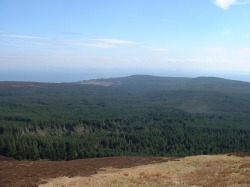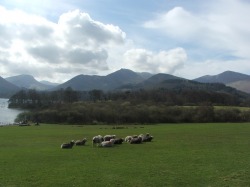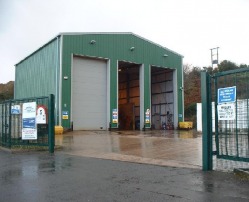Isle of Arran
Timber

Timber Plantations on Arran
The most widely available form of biomass feedstock on the island is timber. The Forestry Commission has owned land on the island for 55 years and currently has 8,000 hectares of plantation forest.[1] On the island there is an additional 1,000 hectares of plantation owned by a number of private landowners. The Forestry Commission plantations are 80% Sitka spruce and the remaining trees are a mix of conifers. Currently around 50% of the felled timber is taken of the island but the small round woods, totaling approximately 25,000 tons, would be immediately available for on-island use.
Vegetable Oil and Farm Waste

Sheep Farming on Arran
The islands largest and most profitable industry is tourism. With many of tourists visiting the island every year there are dozens of restaurants, hotels and guesthouses to cater for them. Each of these will produce waste cooking oil, which on a yearly basis could add up to many thousands of litres. Richardson’s Oil, one of the main suppliers to the island, operates a free collection service of waste oil, which is then fed into the biodiesel market. However, this oil could be kept on the island and processed for use in a specific Arran biodiesel market.
Although almost a quarter of the island is covered in forest there is still wide scale farming across the island. However, most of the farming on the island is livestock based with little or no arable land across much of the island. Farming on the north end of the island is mainly hill farming of sheep, which produces little usable agriculture waste. The south end of the island is more crop based than the north but even here it is predominantly cattle and sheep farming. Therefore the volume of agriculture waste produced will not be sufficient to make any specific waste based system viable. The waste could, however, be feed into another system as general biofuel feedstock.
Although almost a quarter of the island is covered in forest there is still wide scale farming across the island. However, most of the farming on the island is livestock based with little or no arable land across much of the island. Farming on the north end of the island is mainly hill farming of sheep, which produces little usable agriculture waste. The south end of the island is more crop based than the north but even here it is predominantly cattle and sheep farming. Therefore the volume of agriculture waste produced will not be sufficient to make any specific waste based system viable. The waste could, however, be feed into another system as general biofuel feedstock.
Domestic and Municipal Waste

Arran Landfill Site
Composting is already widely used across Arran. A council initiative in 2005[2] has lead to an increase in the number of households composting and the Estate houses and Brodick Castle, all of which have extensive gardens which are constantly maintained, compost there garden waste. The council themselves are one of the largest producers of organic waste, from the cutting of verges, parks, sports fields and hedges across the island. This organic waste was once sent to landfill but is now taken of the island due to the closing of the islands only landfill site. However, the organic waste problem lies with one of the islands biggest producers, the catering industry. Although the islands population is around 5,000[3] people this can rise considerably during the summer months. This equates to large volumes of organic waste as the majority of these tourists will be staying in hotels and eating out at restaurants. Having worked in an Arran restaurant for many years I know that much of this waste is binned and subsequently landfill rather than being composted, and this is much the same across most of the islands catering industry. If all the islands organic waste was collected and composted at a centralised location there could be the potential for methane capture and energy production.
Research
[1] Personal correspondence with Andrew Walker, Arran Forester, Forestry Commission Scotland
[2] Personal correspondence with Brodie Pearce, Operations Support Officer, North Ayrshire Councils
[3] General Register Office for Scotland- http://www.gro-scotland.gov.uk/files1/stats/occasional-paper-10-table1.pdf
[1] Personal correspondence with Andrew Walker, Arran Forester, Forestry Commission Scotland
[2] Personal correspondence with Brodie Pearce, Operations Support Officer, North Ayrshire Councils
[3] General Register Office for Scotland- http://www.gro-scotland.gov.uk/files1/stats/occasional-paper-10-table1.pdf
